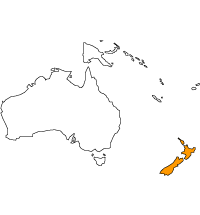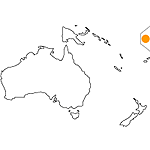|
Parks, Reserves, and Other Protected Areas in |
|
New Zealand
|
|
|
|
 |
Dependencies
|
| Info |
Protected Areas in New Zealand
The Department of Conservation (DOC) is the government department charged with conserving New Zealand’s natural and historic heritage for all to enjoy now and in the future.
As a government department, the Department of Conservation (DOC) is subject to laws passed by Parliament. The Department was formed in 1987 when the Conservation Act was passed to integrate conservation management functions. This Act sets out the majority of the Department's responsibilities and roles.
There is also specific legislation for such things as wildlife, reserves and national parks.
New Zealand has 14 national parks and more than five million hectares - a third of New Zealand - protected in parks and reserves. They embody an incredible variety of landscape and vegetation for so small a country.
Ramsar Wetlands
New Zealand became a party to the Convention on 13th December 1976 and now has 6 sites, covering almost 40,200 hectares, designated under the Convention as Wetlands of International Importance.
World Heritage
The Department of Conservation is the New Zealand State Party representative for the World Heritage Convention, which seeks to ensure the protection and conservation for future generations of cultural and natural heritage of "outstanding universal value".
Sources: Department of Conservation
|
|
|
|
National Parks
- Abel Tasman National Park (www)
- Aoraki/Mount Cook National Park (www)
- Arthur's Pass National Park (www)
- Egmont National Park (www)
- Fiordland National Park (www)
- Kahurangi National Park (www)
- Mount Aspiring National Park (www)
- Nelson Lakes National Park (www)
- Paparoa National Park (www)
- Rakiura National Park (www)
- Te Urewera National Park (www)
- Tongariro National Park (www)
- Westland Tai Poutini National Park (www)
- Whanganui National Park (www)
Marine Reserves
- Auckland Islands (www)
- Cape Rodney-Okakari Point (www)
- Fiordland's Marine Reserve (www)
- Horoirangi (www)
- Kapiti (www)
- Kermadec (www)
- Long Bay-Okura (www)
- Long Island-Kokomohua (www)
- Motu Manawa (Pollen Island) (www)
- Parininihi (www)
- Pohatu (www)
- Poor Knights Islands (www)
- Te Angiangi (www)
- Te Matuku (www)
- Te Paepae Aotea (Volkner Rocks) (www)
- Te Tapuwae o Rongokako (www)
- Te Whanganui-A-Hei (Cathedral Cove) (www)
- Tonga Island (www)
- Tuhua (Mayor Island) (www)
- Ulva Island (Te Wharawhara) (www)
- Westhaven-Te Tai Tapu (www)
- Whangarei Harbour (www)
Marine Parks
- Hauraki Gulf (www)
- Mimiwhangata (www)
- Nga Motu/Sugar Loaf Islands (www)
- Tawharanui (www)
Other Protected Areas
Ramsar Sites
- Farewell Spit (www)
- Firth of Thames (www)
- Kopuatai Peat Dome (www)
- Manawatu River Estuary
- Waituna Lagoon (www)
- Whangamarino (www)
World Heritages Sites
- Subantarctic islands (www)
- Te Wahipounamu - South West New Zealand (www)
- Tongariro National Park (www)
|
|
 |
Cook Islands
National Parks
- Nikao Social Centre
- Suwarrow (www)
Raui
- Aroko Raui
- Parliament Raui
- Pouara Raui
- Titikaveka Raui
Wildlife Sanctuaries
Marine Sanctuaries
- Tikioki
- Motukitiu Reserve
Sanctuaries
- Pukapuka Motu Kotaa
- Motu Ko
- Motu Nuia
- Motu Uta
Reserves
- Aitutaki
- Takitumu Conservation Area
|
| Info |
Protected Areas in Cook Islands
The Cook Islands comprises 15 widely-dispersed islands in the South Pacific Ocean between French Polynesia and Fiji.
The Cook Islands National Environment Service is the central government agency charged with conserving the natural and historical heritage of the Cook Islands, on behalf of and for the benefit of present and future Cook Islanders.
The protection of areas and species of special significance is not a new concept in the Cook Islands. The concept of reserves has existed in the Cook Islands for hundreds of years in one form or another.
Raui System
The imposition of the raui system: a traditional system whereby access to a particular resources or area is forbidden for a given period, is still being practised in the Cook Islands. The selection of areas for which special protection is considered necessary can only be done in close consultation with the island councils and full cooperation by traditional leaders.
Suwarrow Atoll was the first area to be formally established as a National Park in the Cook Islands since 1978 for the protection of the wildlife and the marine resources that it possesses. In 2000 the Nikao Social Centre was declared a National Park under the protection of the Environment Act.
Sources: Cook Islands Government - Cook Islands National Environment Service
|
|
|
 |
Niue
Marine Reserves
Conservation Areas
Heritage and Cultural Parks
Designation Not Known
|
| Info |
Protected Areas in Niue
Niue is the largest raised coral atoll in the world with a total land area of 261 km2. It is situated at 169.55 W and 19.02 S, some 2,400km north east of Auckland, New Zealand and 3900 km north east of Sydney Australia. The island stands alone; its closest neighbour Tonga lies 480 km to the south.
Niueans are Polynesians with a distinct language and culture. Traditional Niuean society is characterised by an absence of a hereditary chiefly system.
Sources: Niue Government - WCPA
|
|
|
 |
Tokelau
Marine Reserves
- Atafu Marine Conservation Area
- Nukunonu Marine Conservation Area
Reserves
- Fakaofo Conservation Area
|
| Info |
Protected Areas in Tokelau
Tokelau consists of three atolls, each with a lagoon surrounded by a number of reef-bound islets of varying length and rising to over three meters above sea level.
The Tokelau Islands were made a British protectorate in 1889. They were transferred to New Zealand administration in 1925. According to a UN report, these low-lying islands will disappear in the 21st century, if global warming continues to raise sea levels.
Sources: Fakaofo Atoll - Nukunonu Atoll - WCPA
|
|





